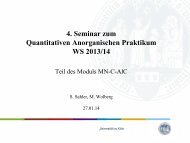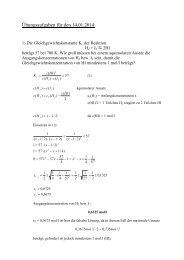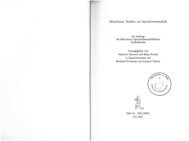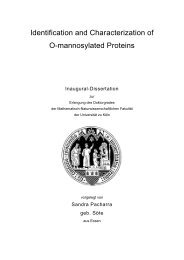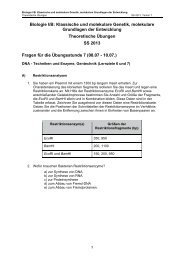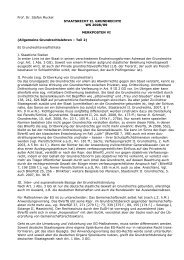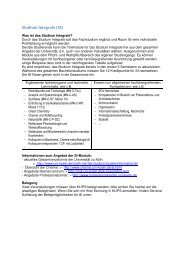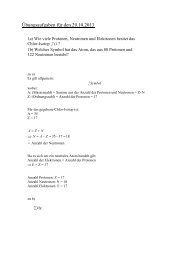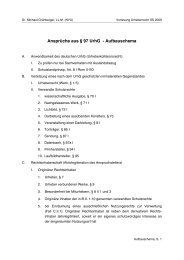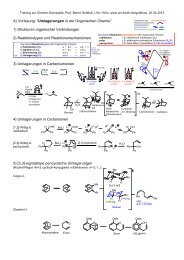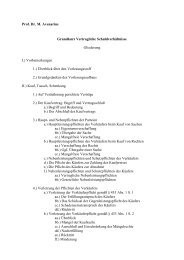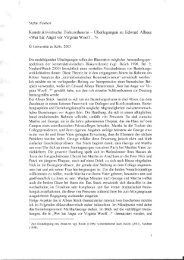Untitled - Universität zu Köln
Untitled - Universität zu Köln
Untitled - Universität zu Köln
Sie wollen auch ein ePaper? Erhöhen Sie die Reichweite Ihrer Titel.
YUMPU macht aus Druck-PDFs automatisch weboptimierte ePaper, die Google liebt.
243<br />
10 SuMMArIES<br />
10.1 SuMMAry<br />
e well-site of Hummal, located in the arid steppe region<br />
of El Kowm (Central Syria), is scientifically important because<br />
of its long archaeological sequence. Beginning probably<br />
over a million years ago, humans visited the spring during a<br />
range of environmental conditions, and their remains can be<br />
found in more than 60 archaeological levels. is book focuses<br />
on the Mousterian deposits, which comprise the uppermost<br />
and longest section of the Hummal sequence. Over<br />
30 archaeological levels display evidence of intermittent site<br />
frequentation by Mousterian hominids. e hominids had<br />
various purposes in gathering at the water source: depending<br />
on the local and regional resource distribution and topography,<br />
the spring could serve either for long-term encampments<br />
or as a place for resource exploitation.<br />
e fragmentation of the archaeological database makes<br />
it difficult to reconstruct the activities that the hunter-gatherers<br />
carried out at Hummal. While imperishable lithic artefacts<br />
dominate the excavated find samples, animal bones and<br />
other organic remains are frequently scarce and severely degraded.<br />
Nevertheless, the results gained by a detailed technotypological<br />
analysis of stone artefacts can be taken for a preliminary<br />
model of site-use patterns. e technological and<br />
typological features of lithic artefacts are likely to prove a valuable<br />
source of information in defining the local and regional<br />
traditions of technology and the relative positioning of the<br />
site in the currently known Levantine Mousterian period.<br />
e Mousterian deposits of Hummal have been under<br />
regular excavation since 2002. Since that time, the western<br />
and southern parts of the well have been examined more<br />
closely, and the two current stratigraphies comprise a sequence<br />
more than 5 m thick. e littoral deposits mirror a steady shift<br />
between water transgressions and regressions, which caused<br />
the development of a broad ecological spectrum ranging from<br />
extended, oxygen-rich lake systems to marshy ponds or waterdepleted<br />
depressions filled with aeolian sands. Colluviated deposits<br />
show evidence of recurring sediment collapses and erosion<br />
processes that were provoked by instabilities in the karstic<br />
bedrock, water flows and weathering.<br />
e changing biotope varied in its attractiveness to both<br />
animals and humans as they searched for drinking water and<br />
food. resource diversity was probably higher in the vicinity<br />
of the artesian springs than in the steppe surrounding El<br />
Kowm, for herds of grazing ungulates gathered at these waterholes<br />
in the course of their annual migration through the<br />
El Kowm gap in the mountain ranges that stretch across<br />
Syria. e animal bones found in the Mousterian levels of<br />
Hummal show that Middle Palaeolithic hunter-gatherers encountered<br />
steppe-adapted species such as horses, gazelles, ostriches,<br />
and camels. Among the camel remains, evidence of<br />
a large-sized species that is now extinct shows Mousterian<br />
hunters had access to considerable masses of meat at times.<br />
In their hunt for these large mammals, the mobile human<br />
groups would have benefited from the strategic position offered<br />
by the El Kowm area.<br />
e hunter-gatherers also benefited from ready access to<br />
the high-quality flint distributed along the Cretaceous and<br />
Tertiary formations to the north and south of Hummal.<br />
Analysis of the lithic assemblages excavated at Hummal suggests<br />
variable patterns of raw material provisioning and use,<br />
and these in turn provide information about technological<br />
strategies in relation to the site’s role in the Mousterian hominids’<br />
land-use system. e principal parameters used for<br />
reconstructing different strategies of the raw-material economy<br />
include the density of lithic waste in a given level and<br />
the composition of artefact assemblages. From the presence<br />
or absence of specific products such as cores, cortical flakes<br />
and tools, as well as their quantity and size, it is possible to<br />
decipher variable provisioning strategies that involved targeted<br />
forays, the transportation of raw material, opportunistic<br />
exploitation of secondary outcrops, or a strong reliance<br />
on personal gear. A statistical test for assemblage types corresponding<br />
to these different strategies for raw material import<br />
and consumption proposes four different assemblage<br />
types. Together with the relevant environmental context,<br />
these types are informative test cases that can be used for a<br />
reconstruction of site functions and land-use systems.<br />
Off-site as well as on-site core reduction saw a systematic<br />
application of the Levallois method to obtain standardized<br />
blanks. e lowermost Mousterian levels of Hummal reflect<br />
the need for a wide spectrum of blank forms that was met<br />
by the application of different flaking methods. Common<br />
features found across the whole sequence, irrespective of<br />
flaking strategy, are the marked elongation of Levallois<br />
blanks, the scarcity of Levallois cores and retouched tools,<br />
and the systematic recycling of flakes and tools into cores.<br />
Although the sample size is small, the oldest lithic industry<br />
(labeled HM-B) is characterized by broad, centripetally<br />
prepared preferential flakes and large blades with<br />
uni- or bidirectional scar patterns. In the upper two-thirds<br />
of the Hummal sequence, a special blank type gains more<br />
and more importance: the Levallois point. is coincides<br />
with a marked uniformity as regards the choice of core reduction<br />
strategies. Triangular blanks were struck exclusively<br />
from one-axis Levallois cores with the recurrent unidirectional<br />
or lineal method. ey are accompanied by elongated<br />
flakes and blades for the production of which the



